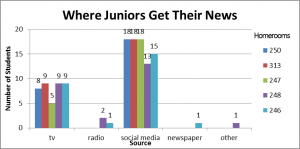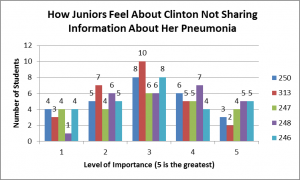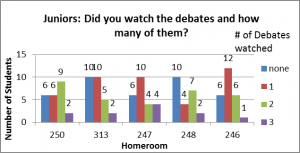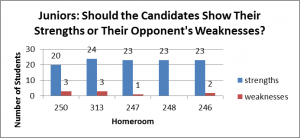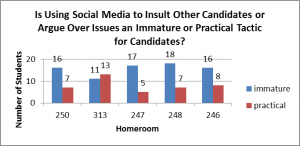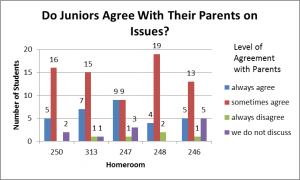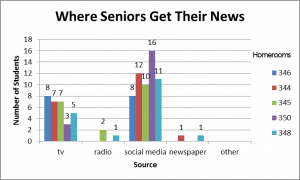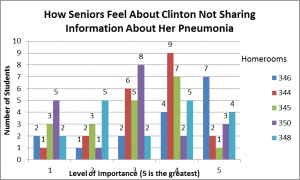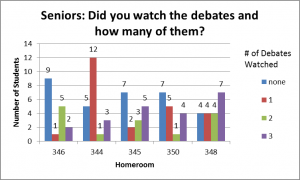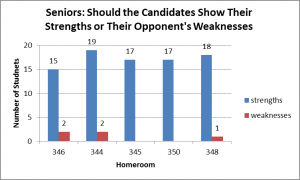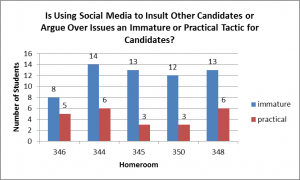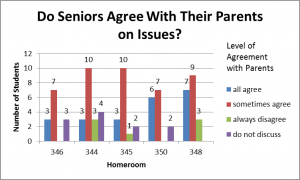The A-Kelly File: Bringing the Presidential Election to SHA
As the Presidential Election drew to a close, I decided to see how my peers in grades 11 and 12 felt about some of the issues. I polled the girls with simple questions about events in the political news thus far and tallied the votes in order to get a sense of where the girls stand. There were three rounds of polls with two questions per week. The data below could not take into account the votes of those girls who were absent on survey days. Here is a summary of how the girls voted in the surveys.
Here are the results for the Juniors, Class of 2018:
Week 1
Question 1: Where have you seen or heard the most advertisements or news about the two candidates? a. TV b. Radio c. Social media d. Newspaper e. Other ____________
The juniors all voted relatively similarly to each other. About 65% of juniors get most of their news via social media (82/127 girls). No one in homerooms 313, 250, or 247 marked that they got most of their information from radio, newspaper, or another source. The prominence of the technological age, especially the influence of the Internet on teenagers, is evident in these results.
Question 2: Hillary Clinton’s doctor diagnosed her with “a mild non-contagious bacterial pneumonia” on Friday, September 9. How important is it to you that Hillary Clinton did not inform her running mate Tim Kaine of her illness until after her public collapse on September 11th? Please rate on a scale of 1-5 (5 as the greatest).
This question brought very mixed results. Just under a third of juniors felt Clinton’s secrecy about her health is of medium importance (3). Only three more juniors marked “5” for greatest importance than juniors that marked “1” for least importance. The graph shows that most people thought that Clinton keeping her sickness so personal nearing the end of the race was of medium importance.
Week 2
Question 1: Have you been watching the presidential debates?
- No
- Yes – I watched one of them
- Yes – I watched two of them
- Yes – I watched all three
This question helped me see the level of involvement and interest the girls have had in the election. Junior homeroom 246 had the highest number of people to watch at least one presidential debate. Homeroom 247, however, had the largest number of juniors that watched all three debates. Just over a third of juniors watched one debate.
Question 2: Should the candidates spend more energy on bringing to the spotlight their own strengths or bringing their opponents down by revealing each other’s weaknesses in order to get votes? A) Promote their own strengths OR B) Show the other’s weaknesses
There has been a lot of name-calling and harsh comments from each of the candidates towards the other throughout this campaign. Ever since the beginning, Clinton and Trump have been exchanging biting remarks. So I wanted to see which option the girls felt would be most beneficial in a candidate’s race to the presidency. The high majority of juniors valued candidates speaking about their own strengths rather than enforcing their opponent’s weaknesses. No one in homeroom 248 thought the candidates should promote their opponent’s weaknesses more than their own strengths. Only 7% of juniors thought promoting the other’s weaknesses would be more effective.
Week 3
Question 1: The candidates have engaged in disputes on social media platforms. Do you feel this is an immature way to campaign for the presidency or a practical way to utilize social media to reach more people?
- Immature
- Practical
Various times throughout the race Clinton and Trump used social media, especially the Twitter platform, to discredit or insult their opponent. This could be viewed in two lights: as immature or as practical. Fighting over the Internet could seem to some like a promotion of cyber-bullying from the candidates. On the other hand, since so many people use social media to communicate, some could view this tactic as a practical way to reach more voters. Homeroom 247 had the highest percentage of juniors (77%) who voted that arguing via social media was immature, but Homeroom 313 was the only junior or senior homeroom to vote more for the practical side of utilizing social media than the immature view (55% voted for ‘practical’).
Question 2: How similar are your political views to those of your parents or guardians?
- We agree on practically all political issues
- We sometimes agree, sometimes disagree
- We always disagree on political issues
- My parents and/or I do not pay attention to nor discuss politics
Political socialization is an important part of government and its participation. By age 10, children have learned the basic political stances of their parents, such as whether they side more with Republicans or Democrats. I surveyed how similar the girls feel their stances are in comparison to their parents. Homeroom 246 had the highest amount of people that do not discuss politics with their parents versus any of the other homerooms, junior or senior. The most popular answer was ‘b.’—61% of juniors said they ‘sometimes agree, sometimes disagree’ with their parents on issues.
The overall answers for seniors were similar, but not exactly the same. Let’s take a look at how senior girls feel about issues.
Here are the results for the Seniors, Class of 2017:
Week 1
Question 1: Where have you seen or heard the most advertisements or news about the two candidates? a. TV b. Radio c. Social media d. Newspaper e. Other ____________
The results were very similar to the juniors. 63% of seniors voted for ‘social media’ as the major outlet for political news versus 65% of juniors. This again solidifies the depth of the impact social media has on teenagers in this day and age.
Question 2: Hillary Clinton’s doctor diagnosed her with “a mild non-contagious bacterial pneumonia” on Friday, September 9. How important is it to you that Hillary Clinton did not inform her running mate Tim Kaine of her illness until after her public collapse on September 11th? Please rate on a scale of 1-5 (5 as the greatest).
These results showed that seniors thought Clinton not being forthcoming with her health was of medium-high importance instead of the juniors’ average of choosing medium importance. Homeroom 346 had the highest spike in students (7 girls) who thought Clinton’s secrecy about pneumonia was a 5, or highest importance.
Week 2
Question 1: Have you been watching the presidential debates?
- No
- Yes – I watched one of them
- Yes – I watched two of them
- Yes – I watched all three
The Kennedy-Nixon debates of 1960 were the first presidential debates to be televised. SHA girls have definitely taken to this use of television to become involved in the presidential race. The percentage of juniors who watched at least one debate was higher than that of seniors, 69% vs. 65%. However the percentage of seniors who watched all three debates was higher than that of juniors, 23% vs. 9%. Homeroom 348 had the largest number of seniors to watch all three presidential debates—7 girls! Perhaps this is because this is the homeroom of the AP Government teacher, Mr. Marino…
Question 2: Should the candidates spend more energy on bringing to the spotlight their own strengths or bringing their opponents down by revealing each other’s weaknesses in order to get votes? A) Promote their own strengths OR B) Show the other’s weaknesses
Seniors had similar views of whether the candidates should promote their strengths or their opponent’s weaknesses compared to that of juniors. No senior in homerooms 345 or 350 thought the candidates should promote their opponent’s weaknesses. A higher percentage of seniors felt promoting strengths was the way to go versus juniors, 95% to 93%.
Week 3
Question 1: The candidates have engaged in disputes on social media platforms. Do you feel this is an immature way to campaign for the presidency or a practical way to utilize social media to reach more people?
- Immature
- Practical
So did seniors feel it was a smart tactic for candidates to use social media to make arguments and accusations or just a juvenile way of trying to get ahead? 72% of seniors voted that this way of communication was more immature than practical. It seems that most SHA girls value the formality and dignity of the presidential debates for this kind of political “smack-talk.”
Question 2: How similar are your political views to those of your parents or guardians?
- We agree on practically all political issues
- We sometimes agree, sometimes disagree
- We always disagree on political issues
- My parents and/or I do not pay attention to nor discuss politics
In all the senior homerooms, the most popular answer was “sometimes agree, sometimes disagree.” No one in homerooms 346 or 350 marked that they do not discuss politics or pay attention to politics with their parents. Overall, girls do have similar views as their parents and agree with them on at least some of the issues.
These results helped me see how involved SHA girls are in this election cycle. This was a hectic and seemingly unconventional race to the White House but Mr. Trump came out on top on November 8th. I will be attending the Presidential Inauguration in January as part of the Envision Chase the Race program I got involved in last year. I’ll surely be back with more about this election, the Inauguration, and what Mr. Trump is planning for the country.
Special thanks to Sr. Kathleen-Mary for her support, Mr. Marino for his guidance, and the juniors and seniors for participating in my surveys–especially all the seniors who helped me go to the homerooms to poll girls (Hannah Ahearn, Jordan Earl, Alexa Fiala, Kylie Gethings, Ally Johns, Stache Jones, Elizabeth Lamont, Johannah Litchfield, Priya Patel, & Olivia Ross). Thanks for being so kind and generous with your time!


